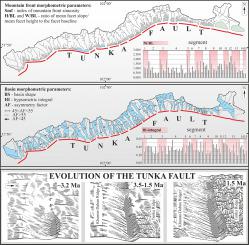Tectonophysics ( IF 2.9 ) Pub Date : 2021-04-21 , DOI: 10.1016/j.tecto.2021.228864 Chebotarev Aleksei , Arzhannikova Anastasia , Arzhannikov Sergey

|
Determining the fault displacement rates and the sequence of formation of intra-rift structures are essential aspects in the study of the evolution of intracontinental rifts. To better understand the development of the Tunka system of basins (Baikal Rift) and the influence of tectonics on landscape evolution, we conducted a morphometric analysis of the Tunka Fault and its transverse drainage network. We studied geomorphic parameters of 64 facets and 74 drainage basins within the Tunka mountain-front in the footwall of the Tunka Fault; these parameters include mountain front sinuosity, the ratio of facet height and width to base length, basin shape, hypsometric integral, asymmetry factor, and the valley width to height ratio. Our main objectives were to determine long-term throw rates for specific mountain front segments and estimate the timing of corresponding geomorphic structures, to characterize the geomorphological response of the transverse drainage systems to fault movements, and to understand the relationship between the morphometry and kinematics of different segments along the Tunka Fault. The analysis of the Tunka mountain front reveals evidence for strong tectonic control on its morphology. We found that the morphological features are strongly influenced by the Late Pleistocene – Holocene kinematic inversion along the eastern part of the Tunka Fault. The Late Pliocene–Quaternary throw rates estimated for specific geomorphic structures vary in the range of 0.8–1.0 mm year−1, which is compatible overall with the long-term throw rates of other basins of the Baikal Rift. Based on these rates, we estimate the age of fault-controlled subsidence of the Tunka and Khoytogol basins and Nilovsky Spur to be between 3.5 and 1.5 Ma. We also show that geomorphological response of the transverse drainage varies along the Tunka Fault, indicating a close relationship between fault kinematics and landscape response.
中文翻译:

基于形态计量学的通卡断层(贝加尔湖裂谷)构造活动的长期投掷率和景观响应
确定断层位移速率和裂谷内构造的形成顺序是研究陆内裂谷演化的重要方面。为了更好地了解通卡盆地(贝加尔湖裂谷)的发展以及构造学对景观演化的影响,我们对通卡断裂及其横向排水网络进行了形态分析。我们研究了滕卡断层下盘的滕卡山前64个面和74个流域的地貌参数。这些参数包括山峰正弦度,刻面高度和宽度与基准长度的比率,盆地形状,水压积分,不对称因子以及谷宽与高度之比。我们的主要目标是确定特定山峰前段的长期抛掷率,并估计相应地貌结构的时间,表征横向排水系统对断层运动的地貌响应,并了解形态学与运动学之间的关系。滕卡断裂沿线的不同部分。对通卡山锋的分析揭示了对其构造进行强力构造控制的证据。我们发现,形态特征受到沿Tunka断层东部的晚更新世-全新世运动学反演的强烈影响。特定地貌构造的晚上新世-第四纪抛物速率估计在每年0.8-1.0mm的范围内变化 以表征横向排水系统对断层运动的地貌响应,并了解通卡断层沿不同断面的形态学与运动学之间的关系。对通卡山锋的分析揭示了对其构造进行强力构造控制的证据。我们发现,形态特征受到沿Tunka断层东部的晚更新世-全新世运动学反演的强烈影响。特定地貌构造的晚上新世-第四纪抛物速率估计在每年0.8-1.0mm的范围内变化 以表征横向排水系统对断层运动的地貌响应,并了解通卡断层沿不同断面的形态学与运动学之间的关系。对通卡山锋的分析揭示了对其构造进行强力构造控制的证据。我们发现,沿屯卡断裂东部的晚更新世-全新世运动学反演强烈影响了形态特征。特定地貌构造的晚上新世-第四纪抛物速率估计在每年0.8-1.0mm的范围内变化 对通卡山锋的分析揭示了对其形态进行强力构造控制的证据。我们发现,形态特征受到沿Tunka断层东部的晚更新世-全新世运动学反演的强烈影响。特定地貌构造的晚上新世-第四纪抛物速率估计在每年0.8-1.0mm的范围内变化 对通卡山锋的分析揭示了对其构造进行强力构造控制的证据。我们发现,形态特征受到沿Tunka断层东部的晚更新世-全新世运动学反演的强烈影响。特定地貌构造的晚上新世-第四纪抛物速率估计在每年0.8-1.0mm的范围内变化-1,总体上与贝加尔湖裂谷其他盆地的长期丢水率兼容。基于这些比率,我们估计通卡盆地和霍伊托戈尔盆地以及尼洛夫斯基山支断裂控制下陷的年龄在3.5到1.5 Ma之间。我们还表明,横向排水的地貌响应沿着通卡断裂发生了变化,表明断裂运动学与景观响应之间有着密切的关系。


























 京公网安备 11010802027423号
京公网安备 11010802027423号